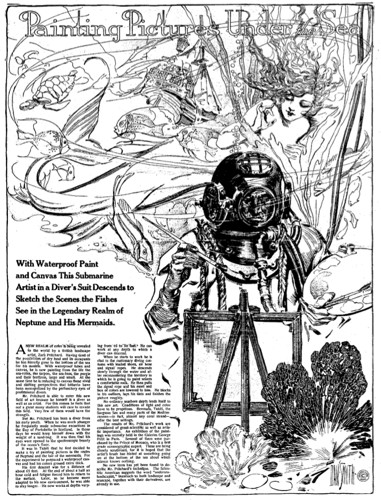Art
The Underwater Art of Zarh Pritchard
Zarh H. Pritchard (1866-1956) is a little-remembered artistic pioneer of the 20th century. (There's not even a wikipedia page about him!) His claim to fame is that he was the first artist to paint underwater.Pritchard would descend to the ocean floor in a diving suit and then paint using waterproof paints on a lambskin canvas soaked in oil. An article in the Fort Wayne Journal Gazette (June 18, 1922) provides more details about the process:
His first descent was for a distance of about 65 feet. At the end of about a half an hour cold and fatigue forced him to return to the surface. Later, as he became more adapted to his new environment, he was able to stay longer. He now works at depths varying from 16 to 50 feet. He can work at any depth to which a diver can descend.
When he starts to work he is clad in the customary diving costume with leaded shoes, air hose and signal ropes. He descends slowly through the water and after reconnoitering the territory in which he is going to paint selects a comfortable rock. He then pulls the signal rope and his easel and box of colors are lowered to him. He blocks in his outlines, lays his tints and finishes the picture roughly.
Some of Pritchard's underwater works are below. They sold quite well. The Prince of Monaco, who was a respected oceanographer in addition to being royalty, was a big fan and bought many of them. Read more about Pritchard here.
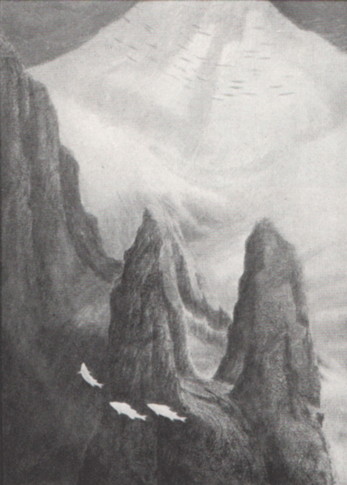
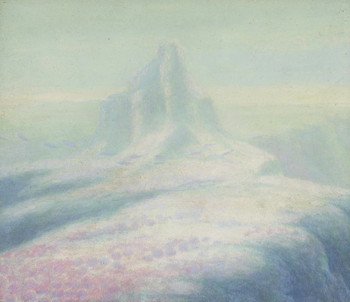
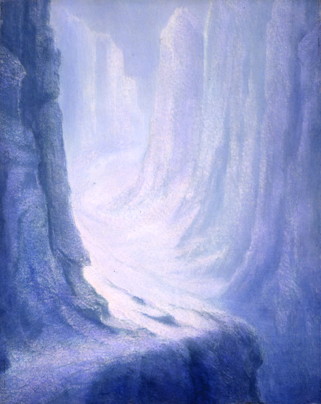
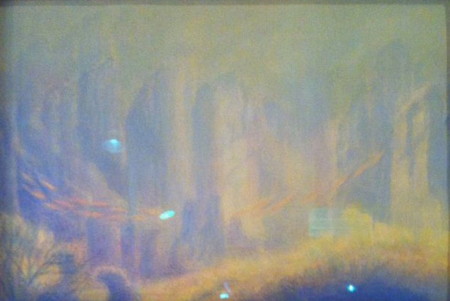
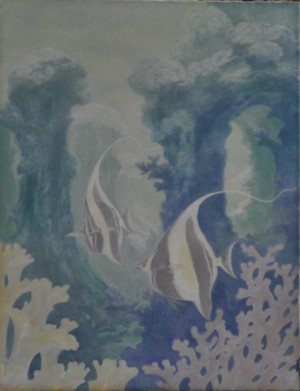
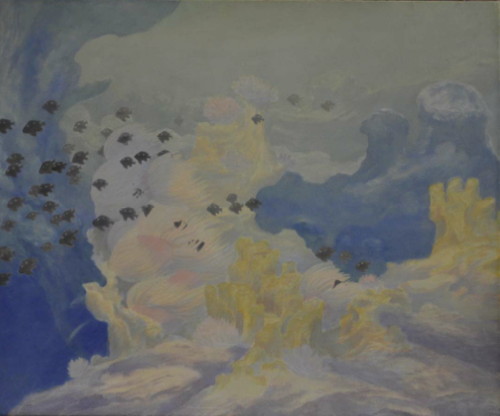
Posted By: Alex - Tue Aug 28, 2012 -
Comments (4)
Category: Art, Oceans and Maritime Pursuits
Walter Pichler’s TV Helmet of 1967
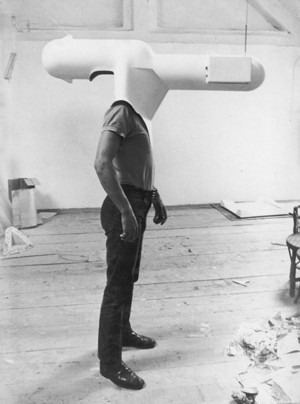
From db-artmag.com:
Read more here.
Posted By: Alex - Sat Aug 18, 2012 -
Comments (7)
Category: Art, 1960s
Shopping Cart Art
Residents of Campbelltown, Australia woke on Sunday to find that someone (presumably teenagers) had stacked shopping carts from local stores into a big pyramid outside the train station. This has sparked a debate in the town about the definition of art. Specifically, is the shopping cart pyramid art, or just vandalism? The mayor of Campbelltown, for one, feels that shopping carts (or shopping trolleys, as they say down there) have no legitimate place in art. Carts, he says, "are only to be used to carry groceries from the shops to your car." Links: Macarthur Chronicle, Facebook.
Posted By: Alex - Tue Jul 10, 2012 -
Comments (6)
Category: Art
Jewel Spew
Artist Kourtney Keller offers the following explanation of what's going on in her video:the subject of JEWEL SPEW is caught in a hypnotic video loop of spewing bling. She is not only surrounded by what is afflicting her, but appears contagious.
Posted By: Alex - Sat Jul 07, 2012 -
Comments (7)
Category: Art, Jewelry, Video
The Complete Blacky Pictures!
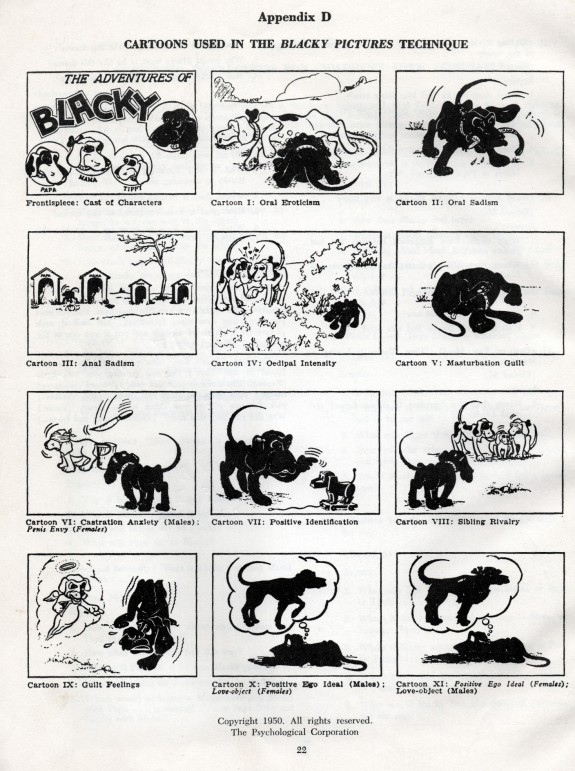
Thanks to the stellar research powers of Alex B., we now have the complete set of these oddball Freudian prompts.
Click on the image to enlarge.
Posted By: Paul - Thu Jun 28, 2012 -
Comments (9)
Category: Art, Children, Alex, 1950s, Mental Health and Insanity
Waves, by Daniel Palacios
From the artist's description:Depending on how we may act in front of it, according to the number of observers and their movements, it will pass from a steady line without sound to chaotic shapes of irregular sounds (the more movement there is around the installation) through the different phases of sinusoidal waves and harmonic sounds.
It's kind of hypnotic, but I kept wondering what happens if the rope breaks. (via coilhouse)
Posted By: Alex - Wed Jun 13, 2012 -
Comments (7)
Category: Art
See Man
Here's more art from Art Domantay (the guy who did the chocolate toilet). This piece is called "See Man". It was exhibited at The Project in the Fall 2002. It consists of "Invisible Man model toy, artist's semen, refrigeration unit."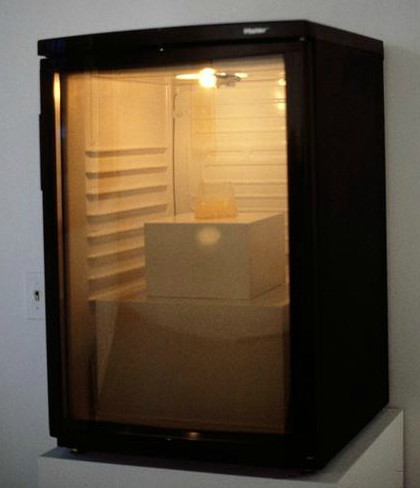
I can't see any invisible man model toy -- must be because it's invisible! Which reduces this exhibit to being this guy's semen in a refrigerator. It would never have occurred to me to call this art. But then, I'm no art critic, so what do I know. I'm just a guy who posts random stuff on Weird Universe.
Edit: After posting this, it occurred to me that the joke is probably that he gets people to peer into the refrigerator looking for the invisible man, but they're really just staring at his man juice. i.e. Do you see the man? Yes I See Man! -- Maybe it is brilliant in its own twisted way.
Posted By: Alex - Sat Jun 09, 2012 -
Comments (4)
Category: Art, Body Fluids
William Harrison, the wax-carving dentist
William P. Harrison was a professor of dentistry at the University of Southern California between 1929 and 1963. He had an unusual way of teaching dentistry skills. He made his students create tiny wax carvings. He figured that if the students had the manual dexterity to make a good miniature carving, they also would have the skill to be a good dentist. Over the years, he amassed a collection of hundreds of wax carvings made by his students. I have no idea what became of them all. It's the kind of thing I'd like to see in a museum, if they were on display. Some text and images below, and more info here:
1955 image of one of Harrison's students making a carving.

Posted By: Alex - Fri Jun 08, 2012 -
Comments (7)
Category: Art
Wim DeIvoye’s Cloaca
Belgian artist Wim DeIvoye has an installation he calls "Cloaca." Food goes in one end, gets processed in various ways, and comes out at the other end as poop — or something closely resembling poop. He's got various versions of this thing: the mini cloaca, personal cloaca, cloaca professional, etc. The version shown here is the "Cloaca New & Improved." It's been displayed at museums throughout Europe.


Posted By: Alex - Mon Jun 04, 2012 -
Comments (11)
Category: Art, Scatology, Excrement
Geoff Ostling wants his tattooed skin hung on a gallery wall as art after he dies
Retired teacher Geoff Ostling is covered in tattoos by Australian artist eX de Medici. He likes them so much that he wants them to be preserved for posterity. So he's bequeathed his skin to the National Gallery in Canberra so that after he's dead it can be tanned and hung on the wall for everyone to see. The Gallery hasn't accepted it yet, and Ostling realizes the bequest is controversial, but he thinks the controversy is a result of people being overly squeamish: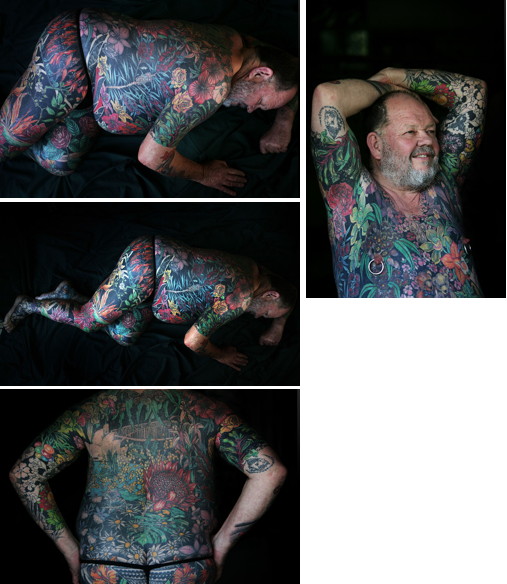
Images via zimbio.com
Posted By: Alex - Fri Jun 01, 2012 -
Comments (12)
Category: Art, Skin and Skin Conditions

| Who We Are |
|---|
| Alex Boese Alex is the creator and curator of the Museum of Hoaxes. He's also the author of various weird, non-fiction, science-themed books such as Elephants on Acid and Psychedelic Apes. Paul Di Filippo Paul has been paid to put weird ideas into fictional form for over thirty years, in his career as a noted science fiction writer. He has recently begun blogging on many curious topics with three fellow writers at The Inferior 4+1. Contact Us |

